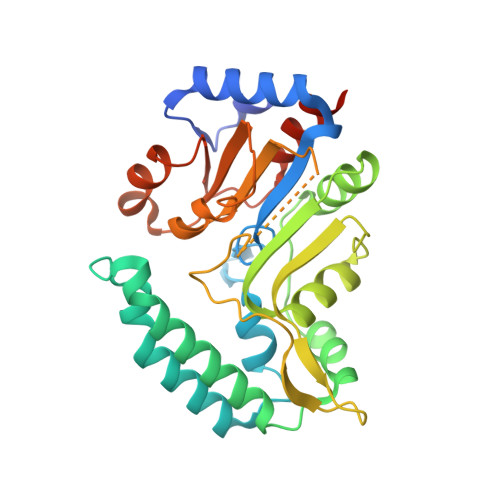Substrate-Based Design of Cytosolic Nucleotidase IIIB Inhibitors and Structural Insights into Inhibition Mechanism.
Kubacka, D., Kozarski, M., Baranowski, M.R., Wojcik, R., Panecka-Hofman, J., Strzelecka, D., Basquin, J., Jemielity, J., Kowalska, J.(2022) Pharmaceuticals (Basel) 15
- PubMed: 35631380
- DOI: https://doi.org/10.3390/ph15050554
- Primary Citation of Related Structures:
7ZEE, 7ZEG, 7ZEH - PubMed Abstract:
Cytosolic nucleotidases (cNs) catalyze dephosphorylation of nucleoside 5'-monophosphates and thereby contribute to the regulation of nucleotide levels in cells. cNs have also been shown to dephosphorylate several therapeutically relevant nucleotide analogues. cN-IIIB has shown in vitro a distinctive activity towards 7-mehtylguanosine monophosphate (m 7 GMP), which is one key metabolites of mRNA cap. Consequently, it has been proposed that cN-IIIB participates in mRNA cap turnover and prevents undesired accumulation and salvage of m 7 GMP. Here, we sought to develop molecular tools enabling more advanced studies on the cellular role of cN-IIIB. To that end, we performed substrate and inhibitor property profiling using a library of 41 substrate analogs. The most potent hit compounds (identified among m 7 GMP analogs) were used as a starting point for structure-activity relationship studies. As a result, we identified several 7-benzylguanosine 5'-monophosphate (Bn 7 GMP) derivatives as potent, unhydrolyzable cN-IIIB inhibitors. The mechanism of inhibition was elucidated using X-ray crystallography and molecular docking. Finally, we showed that compounds that potently inhibit recombinant cN-IIIB have the ability to inhibit m 7 GMP decay in cell lysates.
Organizational Affiliation:
Division of Biophysics, Institute of Experimental Physics, Faculty of Physics, University of Warsaw, Pasteura 5, 02-093 Warsaw, Poland.




















